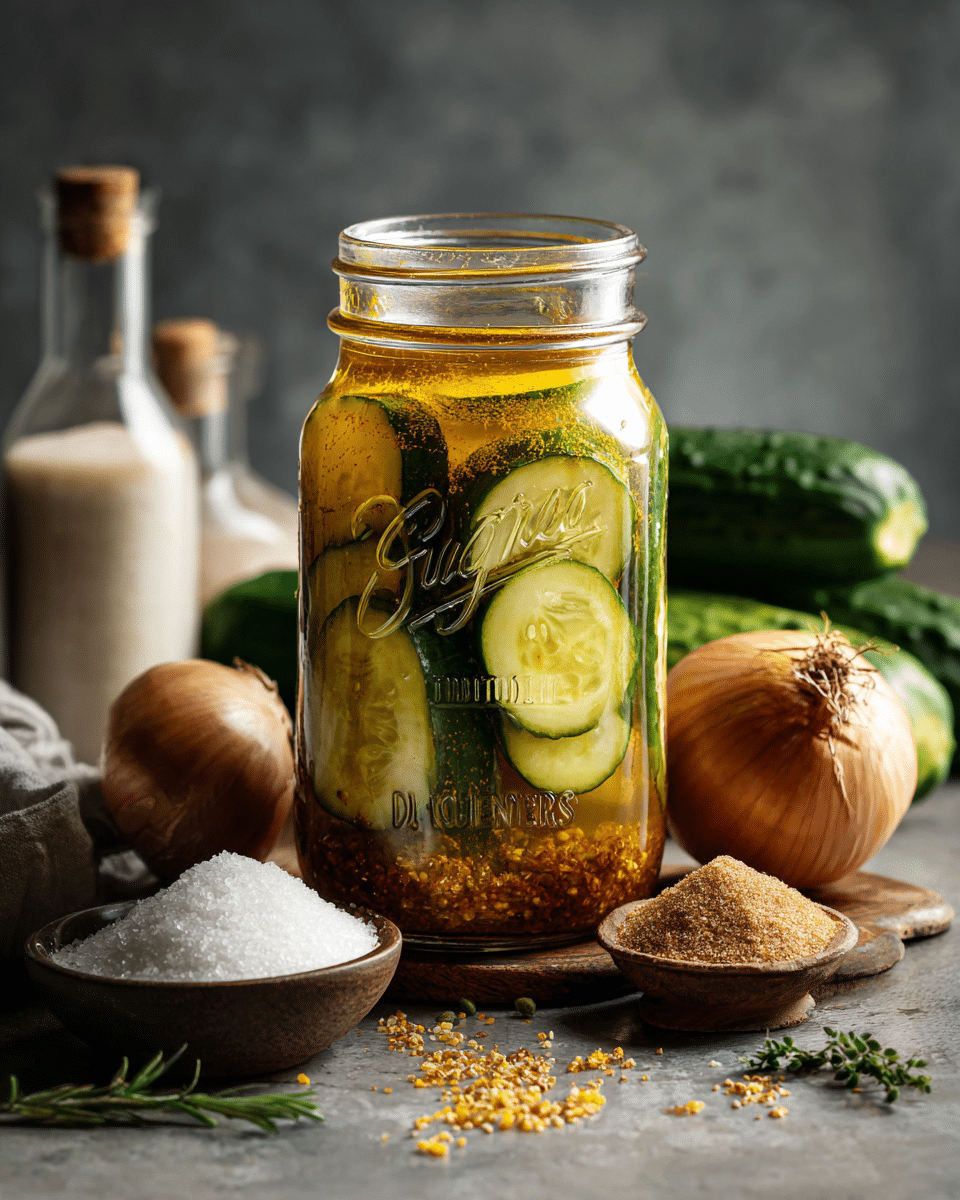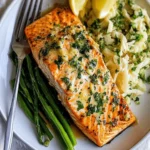These Sugar-Free Bread and Butter Pickles are the perfect keto-friendly alternative to the classic sweet pickles you love. Crisp, tangy, and subtly sweet without any added sugar, they make a delicious snack, salad topper, or burger garnish. Made with everyday ingredients and zero sugar, these pickles fit seamlessly into a low-carb lifestyle while still delivering that signature bread-and-butter flavor.
FULL RECIPE
Ingredients
- 4 cups sliced pickling cucumbers (about 4–5 small cucumbers)
- 1 small yellow onion, thinly sliced
- 1 tablespoon kosher salt
- 1 cup apple cider vinegar
- 1 cup white vinegar
- 1 tablespoon mustard seeds
- 1 teaspoon celery seeds
- 1 teaspoon ground turmeric
- ½ teaspoon crushed red pepper flakes (optional)
- ½ cup granulated erythritol or other keto-approved sweetener
Directions
- In a large bowl, toss the sliced cucumbers and onions with the kosher salt. Let them sit at room temperature for 1 to 2 hours to draw out excess moisture.
- Drain the cucumbers and onions, and rinse them thoroughly under cold water. Pat them dry with paper towels and set aside.
- In a medium saucepan, combine the apple cider vinegar, white vinegar, erythritol, mustard seeds, celery seeds, turmeric, and red pepper flakes.
- Bring the mixture to a boil over medium heat, stirring to dissolve the sweetener.
- Once boiling, reduce the heat and simmer for 2–3 minutes.
- Place the drained cucumbers and onions into a clean 1-quart mason jar (or divide between two pint jars).
- Carefully pour the hot brine over the cucumbers and onions until completely covered.
- Let the jar cool to room temperature before sealing with a lid.
- Refrigerate the pickles for at least 24 hours to allow flavors to develop. They are best after 2–3 days and will keep for up to 1 month in the fridge.
Nutrition Facts
- Calories: 15
- Fat: 0g
- Carbohydrates: 4g
- Fiber: 1g
- Net Carbs: 3g
- Sugars: 0g
- Protein: 0g
- Sodium: 410mg
Health Benefits of Sugar-Free Pickles
Sugar-free bread and butter pickles offer a guilt-free way to enjoy a classic favorite without compromising on your health goals. By eliminating refined sugar and using low-carb sweeteners like erythritol, these pickles become suitable for keto, diabetic, and low-carb diets. They’re low in calories, free of fat, and rich in antioxidants thanks to spices like turmeric. Cucumbers, the base of the recipe, are naturally hydrating and a good source of vitamin K. The fermentation-style brining also introduces beneficial acids that may aid digestion and promote gut health, making these pickles not only tasty but also functional for overall wellness.
Keto Compatibility and Low-Carb Advantage
Traditional bread and butter pickles are loaded with sugar, making them off-limits for anyone on a ketogenic or low-carb eating plan. This keto-friendly version cuts the carbs dramatically by using erythritol, a non-impact sweetener that doesn’t spike blood sugar. The end result is a tangy-sweet flavor profile without the insulin response, supporting sustained ketosis. With only about 3 grams of net carbs per serving, these pickles can be enjoyed as a snack, side dish, or recipe ingredient without derailing your carb count.
Flavor Profile and Texture
These sugar-free bread and butter pickles retain the signature sweet-and-sour punch of the original, balancing tart vinegar with a mellow sweetness from erythritol. Mustard seeds and celery seeds add subtle aromatic warmth, while turmeric lends earthiness and vibrant color. The sliced cucumbers remain crisp and crunchy after brining, and the thin onion slivers soften slightly while soaking up the flavorful brine. The optional crushed red pepper flakes introduce a hint of heat that cuts through the sweetness, offering a more complex flavor profile than typical store-bought varieties.
Ideal Serving Suggestions
Sugar-free bread and butter pickles shine as more than just a condiment. Their versatility allows them to be served with grilled burgers, hot dogs, or low-carb sandwiches to add a zingy crunch. You can chop them up and mix them into egg salad, tuna salad, or coleslaw for an extra pop of flavor. They’re excellent on charcuterie boards, where their acidity cuts through rich meats and cheeses. For a keto twist, wrap them in a slice of bacon or serve them alongside deviled eggs for a party-friendly appetizer that adds visual appeal and textural contrast.
Pairing with Main Dishes
The bright, tangy-sweet notes of these pickles pair beautifully with savory and smoky mains. They complement fatty meats like pulled pork, brisket, or grilled sausages by balancing out richness. You can serve them with roast chicken, turkey, or even keto-friendly fried chicken to add a refreshing bite. On barbecue platters, their acidity plays a palate-cleansing role, making each bite of meat taste just as exciting as the first. They’re also a great addition to lettuce-wrapped sandwiches, grain-free burgers, and even cauliflower “mac” and cheese bowls for a crunch that elevates the dish.
Customization and Flavor Variations
One of the best features of homemade pickles is the ability to personalize the flavor to your taste. You can adjust the sweetness level by increasing or decreasing the erythritol or try other keto sweeteners like stevia or monk fruit blends. For extra spice, increase the red pepper flakes or add sliced jalapeños. If you prefer a more herbal note, add fresh dill, thyme, or bay leaves. You can even use English cucumbers or mini cucumbers for a different texture. The vinegar base is also adjustable—try rice vinegar for a milder flavor or a blend of apple cider and red wine vinegar for more complexity.
Tips for the Best Pickles
Achieving the perfect batch of sugar-free bread and butter pickles depends on a few key techniques. Always salt and drain the cucumbers first to draw out moisture; this preserves their crunch during brining. Use a sharp knife or mandoline to ensure uniform slices, which leads to even flavor distribution. When pouring the hot brine, do so gradually to avoid softening the vegetables too much. Allowing the pickles to chill for at least 24 hours before eating gives the flavors time to meld, but 2–3 days of marinating will deliver the best taste and texture.
Storage and Shelf Life
These pickles are refrigerator pickles, meaning they’re not canned for long-term storage but instead preserved in the fridge. Stored in a clean, tightly sealed mason jar, they will last up to 1 month while maintaining crispness and flavor. Always use a clean utensil to remove pickles to prevent contamination. You may notice slight clouding of the brine or color changes over time—this is normal, especially with turmeric and vinegar interaction—but any strong off smells or mold are signs they should be discarded. For longer shelf life, consider small-batch canning using proper sterilization methods.
Using Leftover Brine
Don’t throw away the leftover brine once the pickles are gone—it’s packed with flavor and utility. You can reuse the brine for a second batch of fresh cucumbers, though the intensity may be slightly reduced. Alternatively, use the brine to marinate thinly sliced red onions or shredded carrots for a quick-pickled veggie garnish. It can also be used as a tangy salad dressing base or even added to Bloody Mary cocktails for a savory twist. Some keto enthusiasts also take a shot of pickle juice pre- or post-workout to help replenish electrolytes naturally.
Comparison to Store-Bought Versions
Most commercially available bread and butter pickles are loaded with sugar and preservatives, making them unsuitable for low-carb diets. Even so-called “sugar-free” brands often contain artificial sweeteners that may affect blood sugar or cause digestive discomfort. Making your own ensures full control over ingredients, freshness, and flavor. Homemade pickles are often crunchier, cleaner-tasting, and better suited for dietary needs. You can scale the batch up or down as needed and avoid the high sodium and added fillers found in many store-bought options.
Conclusion
Sugar-Free Bread and Butter Pickles offer a satisfying and healthy alternative to their sugary counterparts, proving that you don’t have to give up flavor to stay on track with your dietary goals. With their perfect balance of tangy, sweet, and spicy notes, these keto-friendly pickles are a must-have staple for low-carb kitchens. Whether you’re serving them alongside grilled meats, jazzing up a salad, or simply enjoying them as a crunchy snack, they bring both bold flavor and real nutrition to the table. Plus, the freedom to customize and store them easily at home makes this recipe a go-to for anyone seeking healthier, homemade pantry staples.






